
The radioisotopes in the middle of the 20th century seemed like an almost endless source of cheap electricity - reactors were about to come to planes, cars, and even houses, they thought then. But this only happened in the world of Fallout. Why is nuclear energy at an impasse and will we catch its sunset? In this article, we talk about unsuccessful attempts to make a peaceful atom closer to people - we continue a series of posts about energy sources.
A peaceful atom could play a very important role in reducing carbon dioxide emissions without reducing global electricity production. But did not play.
After the Chernobyl disaster, enthusiasm for nuclear power plants subsided - nobody liked the prospect of an unlikely, but possible radioactive contamination of entire regions. The Fukushima disaster only accelerated the abandonment of nuclear energy in Europe. In the European Union, where, from the border to the border, roughly speaking, “at hand” any leak of nuclear fuel will cover several countries at once.
In Italy, the last nuclear power plant stood in 1990. Since 2000, Germany began to systematically abandon nuclear power, and after the Fukushima accident, eight out of 17 reactors in the country were shut down at once. Belgium will shut down all seven of its reactors by 2025. Switzerland will shut down reactors by 2034. The countries of America, the Middle East and Asia are in no hurry to stop their nuclear power plants and are even building new ones, but together with them they are actively developing green energy. And in Germany in 2019, the amount of electricity received from the sun, wind, water and biomass exceeded that of power plants in fossil, including nuclear, fuel.
 The share of nuclear energy in countries. After 10 years, green spots in Europe will disappear. And even China has invested $ 380 billion in the construction of wind and solar stations. Source: PRIS - Country Statistics / Wikimedia
The share of nuclear energy in countries. After 10 years, green spots in Europe will disappear. And even China has invested $ 380 billion in the construction of wind and solar stations. Source: PRIS - Country Statistics / Wikimedia
NPPs account for about 10% of the world's electricity, and their share is slowly declining. And for renewable sources - 20%, with the highest growth being shown by wind energy (4.5 times in 10 years) and solar stations (25 times in 10 years). Of course, it is too early to bury the nuclear power plant, but who knows what awaits us in the next 20 years. In the late 1990s, no one could have thought that windmills and solar panels would occupy at least a significant part in the global energy industry.
During the golden age of the atom, scientists tried to make these technologies safer, more accessible and understandable to people, but a number of unresolved and unsolvable problems buried promising ideas or narrowed the scope of their application to a minimum. Here are some of these ideas.
A flying reactor that didn’t take off
In the 1950s, when the romantic flair for the nuclear future had not yet been dispelled, atomic reactors tried to experiment wherever possible. It is no secret that the main customer and investor of scientists in the United States is the Department of Defense, and then it was ready to finance the craziest projects.
In the very beginning of the 50s, talk about the inevitable war with the USSR, moreover a nuclear war, was already floating in the air. With the delivery of nuclear weapons at that time there was trouble: rocket science was in its infancy, and the first post-war bombers simply did not have time to get to the territory of a potential enemy in the event of a conflict. It was necessary that the military aircraft were constantly in the air as close as possible to the places of the alleged bombing. So, we need an aircraft engine that can work days and weeks without refueling.
The program for installing a nuclear reactor in an airplane started in the United States as early as 1946. The two largest aircraft engine developers, General Electric and Pratt & Whitney, presented their versions of a ramjet engine. The principle of their operation was brilliantly simple: after take-off on ordinary fuel, the air entering the air intakes entered the reactor, passed through thousands of channels heated above 1000 ° C and created reactive thrust at the outlet.
 Direct-flow nuclear engine General Electric HTRE-3. Source: Federal Government of the United States / Wikimedia
Direct-flow nuclear engine General Electric HTRE-3. Source: Federal Government of the United States / Wikimedia
The idea was awesome: even by conservative estimates, an aircraft with such an engine could be in the air for weeks - as long as there was enough food and water from the crew. In practice, there were problems that you probably already guessed about. First, the reactor created a loop of ionizing radiation and thereby significantly spoiled the territory over which it flew over. It was possible to get rid of the exhaust with the help of a dual-circuit system, as in nuclear power plants, but then the efficiency of the engine fell sharply - the aircraft could hardly carry itself without a payload. Secondly, the biological protection of the crew was not ideal, and a qualified military pilot, especially a strategic bomber pilot, is a golden resource. Thirdly, the fall of such an aircraft in any territory (except enemy) would lead to an international scandal and environmental disaster. In general, they put the reactor on the plane, but only one - the NB-36H became the only experimental board (in the very first photo in this material), and the engines on it were not connected to the reactor.
The crew was protected by a lead and rubber structure, which added 11 tons to the mass of the aircraft, but still could not completely shield people from radiation. On board the bomber carried a 1-MW water-cooled reactor weighing 16 tons. The aircraft flew for 215 hours, of which 89 hours with a working reactor; tests were conducted exclusively over the desert regions of Texas and New Mexico.
The idea of an atomic bomb was abandoned in 1961 by order of President Kennedy against the backdrop of a “thaw” in relations between the two superpowers. But this did not mean that the United States completely buried the nuclear engine program for aircraft.
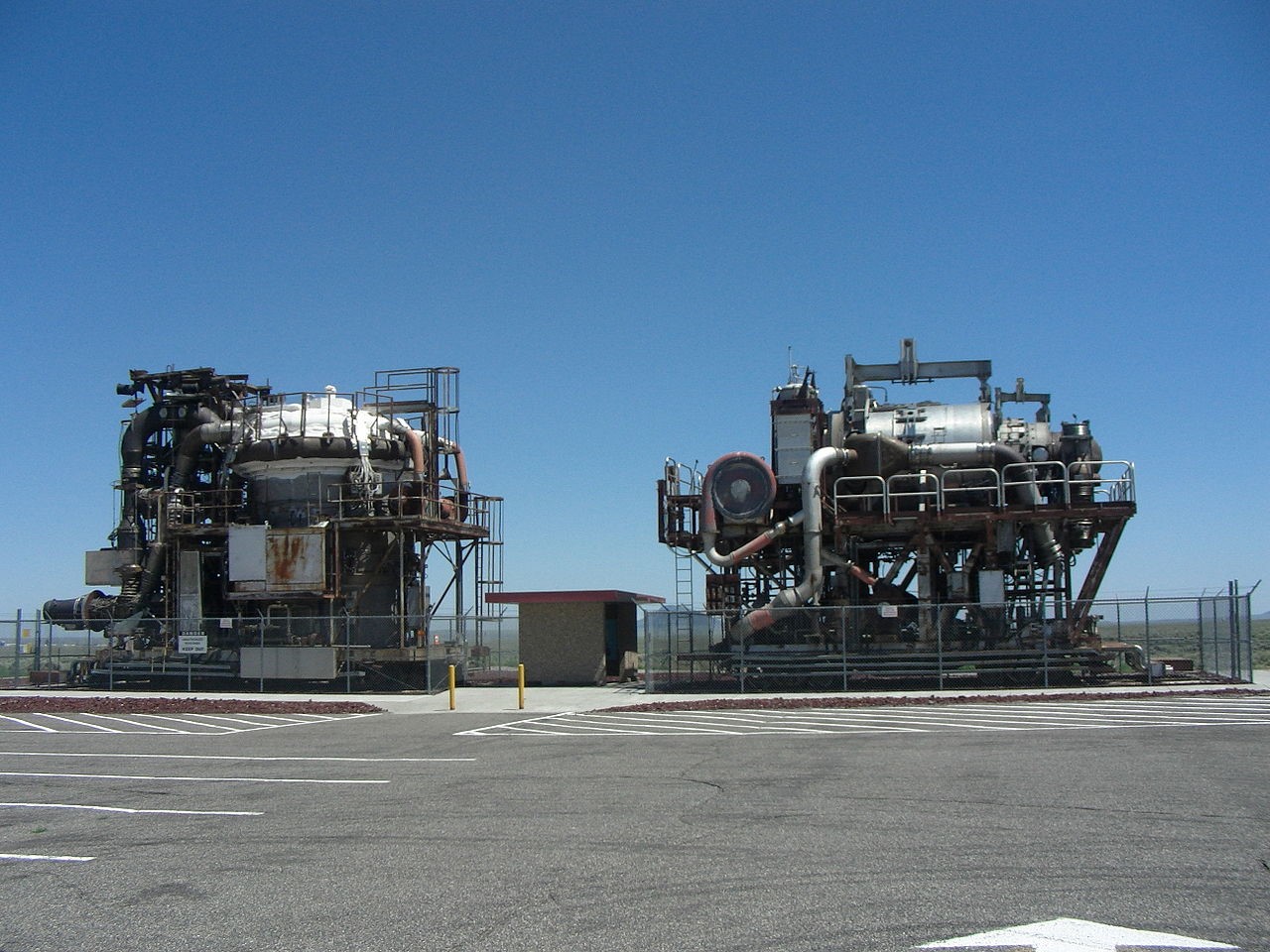 35 MW General Electric HTRE-2 and HTRE-3 engines are now openly located in the parking lot of the Idaho National Laboratory, where they were tested. Source: Wtshymanski / Wikimedia
35 MW General Electric HTRE-2 and HTRE-3 engines are now openly located in the parking lot of the Idaho National Laboratory, where they were tested. Source: Wtshymanski / Wikimedia
Similar projects, as you might guess, existed in the USSR - on both sides of the planet, trends in military affairs were similar. In 1955, work began on the creation of a nuclear aviation power plant, and aircraft for it were to be developed by the Design Bureau of Tupolev and Myasishchev. For testing, a promising strategic Tu-95M bomber was taken (by the way, it is still in service). By 1958, the Tu-95LAL aircraft with a reactor in the cargo compartment was ready. During the summer of 1961, the laboratory aircraft made 34 flights. As in the American project, it was supposed to use conventional NK-12M turboprop engines for take-off, and the reactor was connected already at a height.
Unlike the Americans, Soviet engineers shielded the crew with partitions made of polyethylene and ceresin with an additive of boron carbide, which were more effective and much lighter than rubber with lead.
The project was named Tu-119, and the bomber itself was generally quite viable. But after the United States, the development of the Soviet atomic aircraft was stopped in the early 1960s. It is possible that for the same reasons: the "thaw", the development of rocket science and the danger of collapse. And, of course, the price: bringing the Tu-119 to serial production cost 1 billion Soviet rubles.
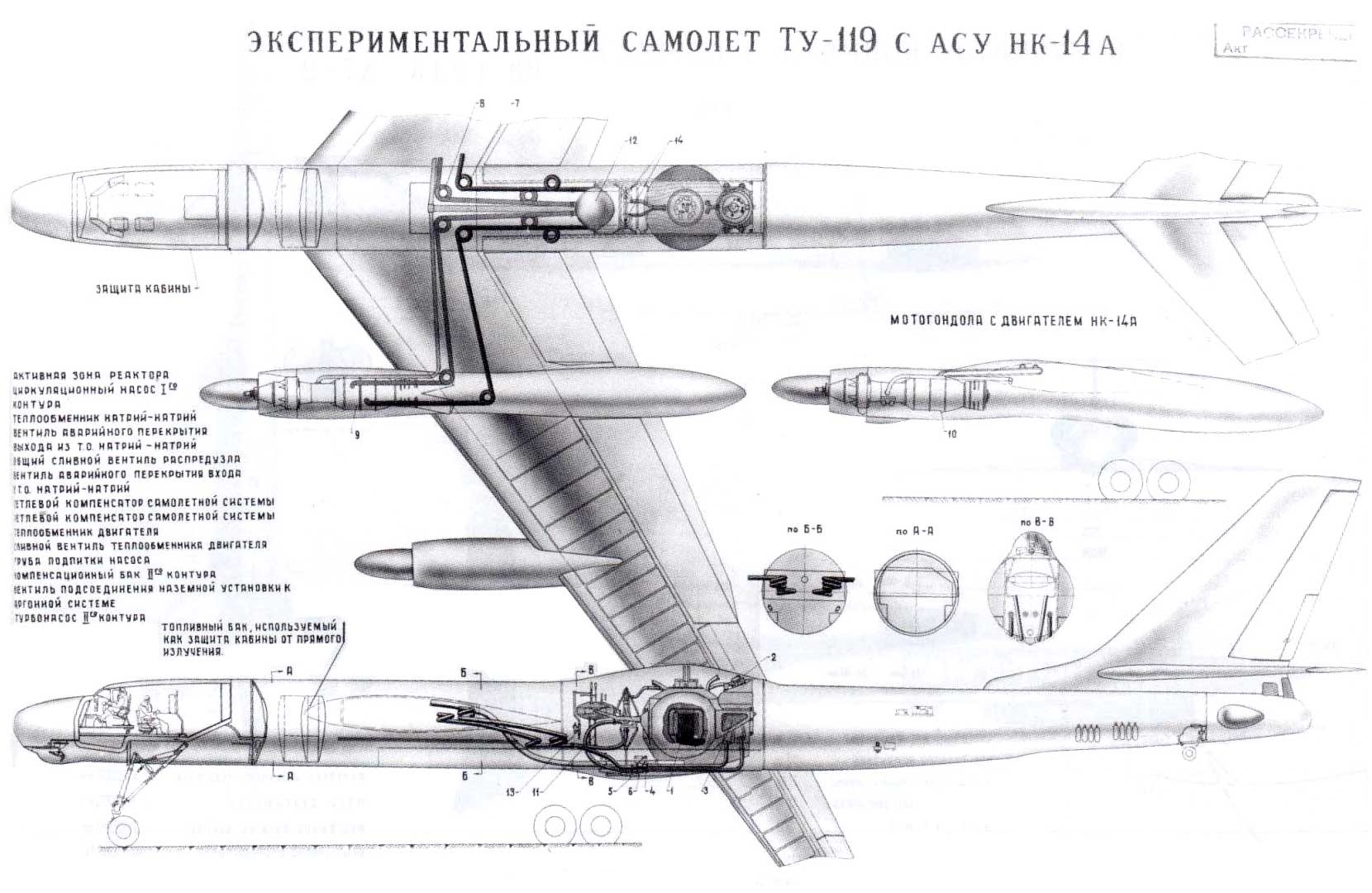 The declassified design of the Tu-119 clearly shows the location of the reactor. Source: KB Tupolev
The declassified design of the Tu-119 clearly shows the location of the reactor. Source: KB Tupolev
The 1960s marked a shift in military priorities from bombers to intercontinental missiles. And here just flying reactors would be very out of place - there are no people in the rocket who need radiation protection, food and water, the rocket can fly for months, and at the right time maneuver and deliver nuclear greetings from the other side of the ocean.
The Pluto project, launched in the USA in 1957, aimed at creating a missile with a nuclear warhead and an atomic reactor as an engine, similar to what they unsuccessfully tried to attach to bombers.
The product, called SLAM (Supersonic Low Altitude Missile, a supersonic low-altitude missile) was supposed to fly at an altitude of up to 300 meters at a speed of 4200 km / h. But this project was not implemented: the rocket, even in theory, turned out to be unacceptably expensive and "dirty" (more about this project is described
here ).
In addition, when the project was formally ready, conventional intercontinental missiles already got rid of childhood diseases. They turned out to be much cheaper, safer and easier to use. And the new time seems to have brought us the Russian Petrel, but its review is beyond the scope of this post.
We add that if nuclear missiles were not realized in the 20th century, then satellites are quite. In 1965, the Americans launched the Snapshot apparatus with the SNAP-10A reactor into low Earth orbit. He was supposed to “sag” there for a year, generating electrical power of about 500 watts. But on the 43rd day of the flight, the on-board voltage regulator failed, the power jumped to 590 W, and the reactor was shut off. It was assumed that SNAP-10A would be in orbit as space debris for the next 4000 years, but by 2008 the device had collapsed into many fragments less than 10 cm in diameter. Most likely, he collided with other space debris.
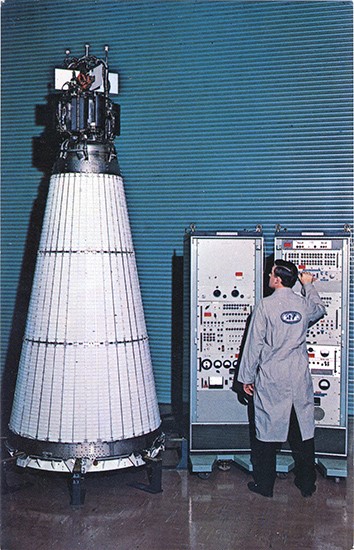 500W SNAP-10A Space Reactor The one that now flies around the Earth in the form of debris. Source: US DOE / Wikimedia
500W SNAP-10A Space Reactor The one that now flies around the Earth in the form of debris. Source: US DOE / Wikimedia
In the USSR, low-power nuclear power plants have been successfully used on spacecraft since the 1970s. In particular, they fed the reconnaissance satellites of the Legenda system with a total of about three dozen. But even here, a series of incidents put an end to the use of nuclear reactors - at least in low Earth orbit. And all because even if something goes wrong in space, radioactive debris still flies to Earth. In 1978, an unpleasant incident occurred with the Soviet Cosmos-954 satellite equipped with a Buk nuclear installation: after a month of working in orbit, the spacecraft spontaneously went home to Earth, collapsed in dense atmospheric layers and generously scattered over 124 thousand square meters. km of the Canadian Arctic 30 kilograms of uranium-235. Fortunately, the sparsely populated Northwest territories of Canada helped to avoid the tragic consequences. Search expeditions collected 65 kg of various debris, some of them fonil under 200 x-rays / hour.
In 1983, Cosmos-1402 dived into the warm waters of the Indian Ocean. And although the reactor burned out in the atmosphere, the fine residues of uranium-235 from it were still recorded for a long time in sediments.
And when the Cosmos-1900 crashed in 1988, it was automatically sent to the burial orbit. But by that time, the world community had formed a very strong prejudice against the use of reactors in spacecraft.
An alternative to a compact flying reactor is a radioisotope thermoelectric generator, and it was he who found wider application in practice. But also not at all what atomic energy enthusiasts had hoped for.
Radioisotope Thermoelectric Generator (RTG)
In 1912, the British physicist Henry Moseley created the first radioisotope power source: in the center of a glass flask with silver-plated walls, a radium radiation source was installed on the electrode, emitted beta particles create a potential difference between silver and radiation, which causes voltage to appear on the bulb's electrodes.
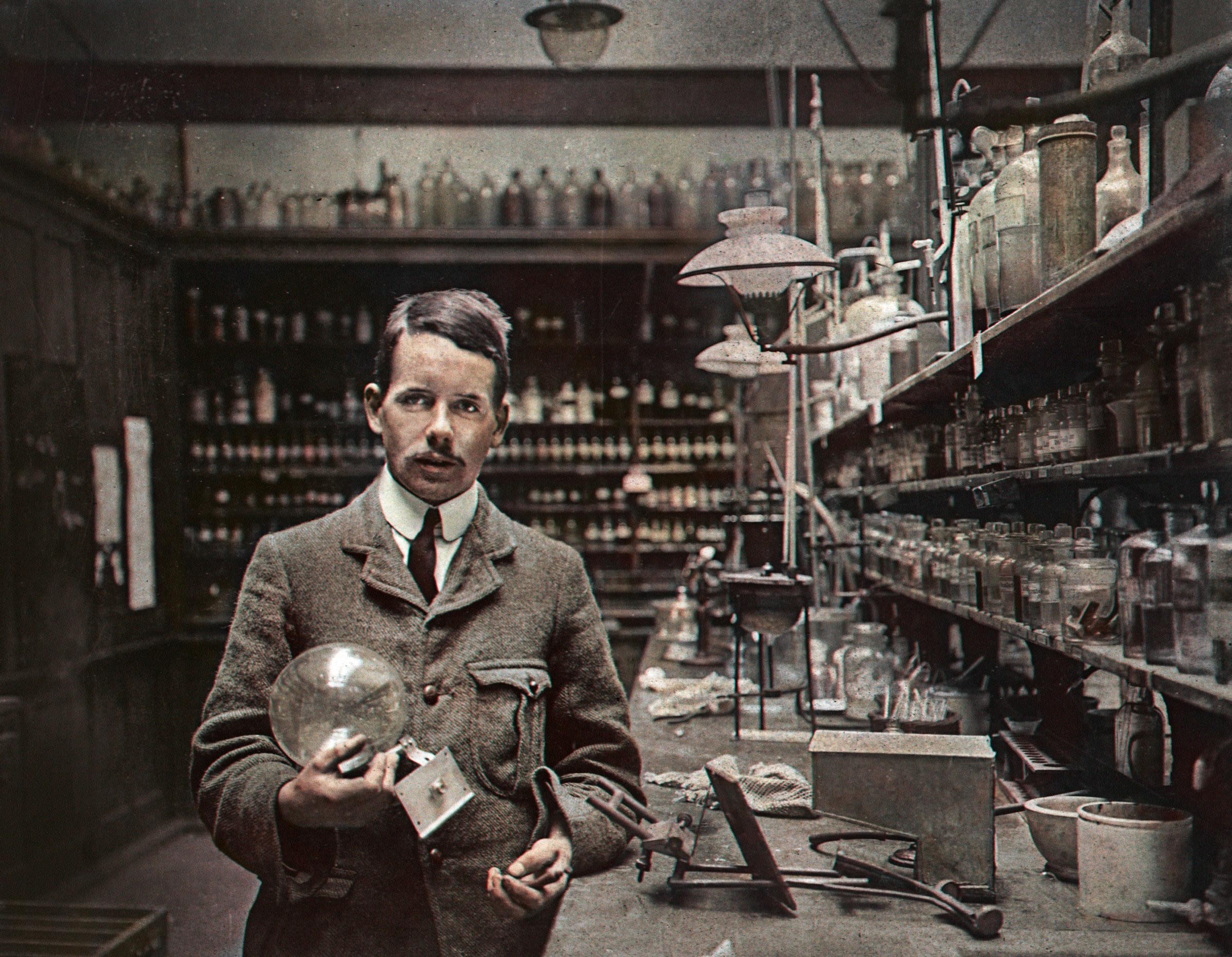 Henry Moseley with one of his flasks used to study x-rays. Unfortunately, the life of a promising scientist and inventor was cut off by a sniper bullet at the battle of Gallipoli during World War I. Source: New York Public Library
Henry Moseley with one of his flasks used to study x-rays. Unfortunately, the life of a promising scientist and inventor was cut off by a sniper bullet at the battle of Gallipoli during World War I. Source: New York Public Library
During radioactive decay, the substance heats up, sometimes to the highest temperatures. The generated heat RTGs are converted into electricity using thermoelectric generators.
A thermoelectric generator is a simple but very entertaining thing. Two centuries ago, in 1821, German Thomas Seebeck discovered that with a temperature difference between two conductors, electricity is generated due to the formation of a potential difference during the flow of heat from one conductor to another. By the way, the opposite effect of this phenomenon, discovered in 1834 by Jean-Charles Peltier, formed the basis of processor coolers on Peltier elements, which were not produced for long in the early 2000s: if you let current between dissimilar conductors, one of them heats up, and the other, on the contrary, it will cool.
 The structure of the thermoelectric generator is very simple and understandable, so the creation of RTGs rested not in technological limitations, but in the absence of isotopes in the required quantities. Source: Wikimedia / Ken Braizer
The structure of the thermoelectric generator is very simple and understandable, so the creation of RTGs rested not in technological limitations, but in the absence of isotopes in the required quantities. Source: Wikimedia / Ken Braizer
If electricity can be so easily obtained from the heat, which is abundant on our planet (solar, hydrothermal and petrothermal energy), then why are there no power plants on thermoelectric generators? Because the efficiency of such a generator, to put it mildly, is not very - about 6-10% of the thermal power. To get more or less decent power of a portable RTG, one has to look for radioisotopes with high heat generation and a long half-life.
On the other hand, even with such a low efficiency, you can live and work: a radioisotope source is enough to power LED lighting, a variety of sensors and control systems, and organize backup power with it. What is not an option for individual energy supply of houses that will not remain without electricity even in the event of a natural disaster?
The properties of very many isotopes were studied, but there were very few elements suitable for RTGs: the requirements for power sources were too stringent. For example, plutonium-238, which is almost safe due to low beta and gamma radiation used in spacecraft and pacemakers, emits about 0.54 W of heat per gram of substance, and its half-life is 88 years. Over the year, RTGs on plutonium-238 will lose 0.78% of the starting capacity. A source on plutonium will last a long time, but to get a couple of hundred watts you have to load a few kilograms of the substance.
But just look at polonium-210, this is a real “stove” - as much as 140 W of heat per gram, 2,000 times more plutonium! Yes, here's the problem, the half-life of polonium is only 138 days. You cannot fly far with such an RTG.
 Typical design of a modern RTG: isotopic core, many pairs of thermoelectric generating conductors and a mandatory radiator on the body that removes excess heat. Source: NASA / Wikimedia
Typical design of a modern RTG: isotopic core, many pairs of thermoelectric generating conductors and a mandatory radiator on the body that removes excess heat. Source: NASA / Wikimedia
Half a century passed between the discovery of Henry Moseley and the appearance of RTGs - they were given the start of life by nuclear reactors, on which it was possible to produce isotopes in large volumes. Work on RTGs began in the 1960s, when SNAP-1 (Systems for Nuclear Auxiliary Power) was created in the USA. SNAP-1 was rather a “steam engine” at cerium-144, in which mercury was used instead of water.
Following SNAP-1, SNAP-3 was developed with a plutonium-238 thermoelectric generator. The device weighed about 2 kg and produced 2.5 watts of power. SNAP-3 powered the Transit American navigation satellites, the predecessors of GPS.
The successful experience of SNAP-3 marked the beginning of the era of radioisotope power supplies in spacecraft, which require compact, long-playing and maintenance-free "batteries". And yes, in the SNAP series there were not only thermoelectric generators, but also full-fledged nuclear reactors, which we mentioned above.
The use of RTGs in the space industry is so far the only solution to the energy problem for small interplanetary probes. The efficiency of solar panels decreases with distance from the sun. NASA has clearly explained this problem in the illustration.
RTGs have found their place in the Voyager (160 W) spacecraft that have already gone beyond the solar system, the Cassini, New Horizons and Galileo interplanetary stations (300 W), the Curiosity rover (110 W), and even in the Apollo lunar program spacecraft (73 W ) Moreover, such sources not only power, but also heat the electronics - 90% of the thermal energy goes to radiators.
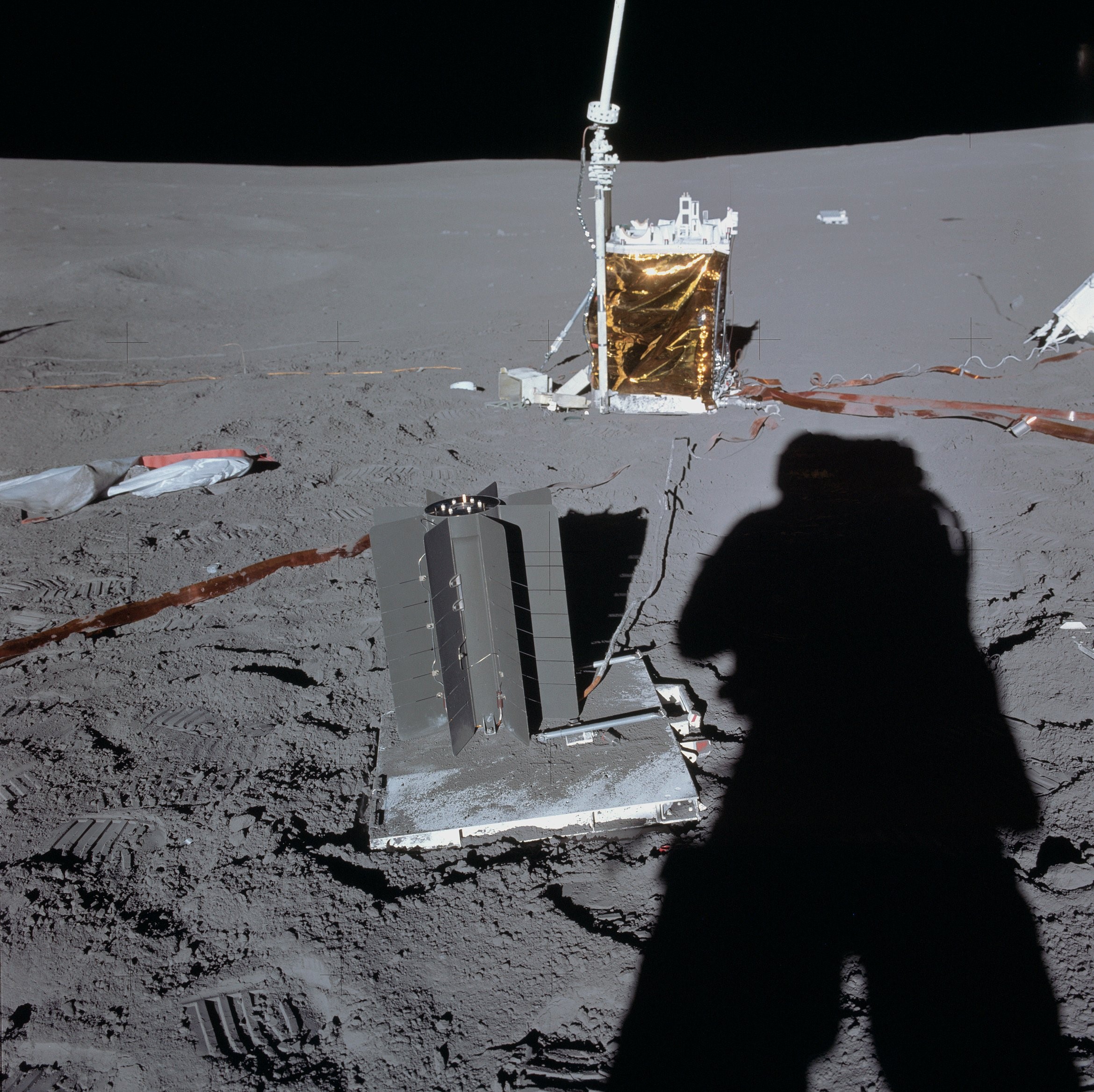 A gray cylinder with eight “wings” in the center of the photo - SNAP-27 RTG, generating 75 watts at 30 V DC, it was used on the moon during the Apollo 14 mission. Source: NASA, Alan Shepard / Wikimedia
A gray cylinder with eight “wings” in the center of the photo - SNAP-27 RTG, generating 75 watts at 30 V DC, it was used on the moon during the Apollo 14 mission. Source: NASA, Alan Shepard / Wikimedia
However, even in space, RTGs are rarely used. The prospect of an accident involving a source of radioactive radiation that has gone into outer space does not, in general, concern the population of our planet, but it is much worse if a nuisance occurs on Earth, for example, from the actions of someone else’s troubled hands. And nobody canceled unsuccessful missile launches. So, in 1964, the American Transit-5B satellite with RTG SNAP-9A collapsed at launch, scattering almost a kilogram of plutonium-238 in the atmosphere. In 1968, again, the American Nimbus B-1 weather satellite with SNAP-19B2 did not infect the ocean into which it fell, only thanks to an improved capsule design with 1 kg of plutonium-238. Finally, the large Russian research apparatus Mars-96 in 1996 left orbit and buried 270 grams of plutonium-238 on the bottom of the Pacific Ocean.
 A steel capsule with a plutonium-238 isotope for the Nimbus B-1 weather balloon and it is also on the ocean floor. Source: NASA
A steel capsule with a plutonium-238 isotope for the Nimbus B-1 weather balloon and it is also on the ocean floor. Source: NASA
And now the disturbing news: RTGs are used not only in space, but also on land. In the 20th century, they were used to power sea buoys and uninhabited lighthouses in remote areas of the planet, for example, in the Arctic. Worn buoys and lighthouses are now collected and disposed of to prevent the leakage of nuclear fuel. Sometimes RTG cases are damaged during maintenance, transportation, or simply during operation - 23 incidents have occurred in the CIS over the past 36 years. Moreover, in some of them the power supply enclosure was destroyed by non-ferrous metal collectors. Sawing an RTG with hard alpha radiation is more dangerous than disassembling a high-explosive projectile with a sledgehammer - at least the projectile may not explode, but there is no way to hide from the radiation of uranium or plutonium. Especially if the vandal breathes uranium dust.
But what if RTGs become widely available? So to the "dirty bomb" is not far. The turnover of radioisotopes is regulated like nothing else, so you should not wait for the weakening of control and the emergence of RTGs somewhere other than space and the “defense industry”. The only area where radioisotope power supplies became “closer to people” was batteries for pacemakers. Yes, and there they have long been replaced by lithium-ion batteries.
 Battery for pacemaker from which plutonium-238 is extracted. Source: Oak Ridge Associated Universities
Battery for pacemaker from which plutonium-238 is extracted. Source: Oak Ridge Associated Universities
Small reactor house reactor
Obviously, from such radioisotope sources, it would not be possible to power the house with all the desire. Then what about your own reactor, which could be placed behind the house? Of course, the wonders of compact Mr. Fusion from the movie "Back to the Future 2" scientists have not prepared for us. But some progress in the field of low power nuclear power plants (AFMMs) is noticeable, however, even the most promising projects are still in a very uncertain status.
The construction of a small nuclear power plant on a compact reactor seems to be an excellent solution for powering remote small towns in which there is no opportunity for green energy, and transporting fossil fuels is long and expensive. We take some kind of circumpolar settlement, where even a cooling pond cannot be organized, and put a tiny 100 MW nuclear power plant there - quickly, conveniently and even inexpensively! With such thoughts, numerous ACMM projects were developed. But what seemed simple and affordable on paper turned out to be expensive and complicated.
One of Toshiba’s developments in the field of energy has become low-power reactors. The project, called Toshiba 4S, was a modular maintenance-free reactor with a capacity of 10 to 50 MW. 4S is an abbreviation for Super-Safe, Small and Simple, that is, "ultra-reliable, compact and simple." The device is a 30-meter sealed enclosure, inside of which there is a reactor core without control rods. Instead of rods around the perimeter of the core, neutron reflector panels are installed that support the reaction, and in the event of an emergency, stop the chain reaction.
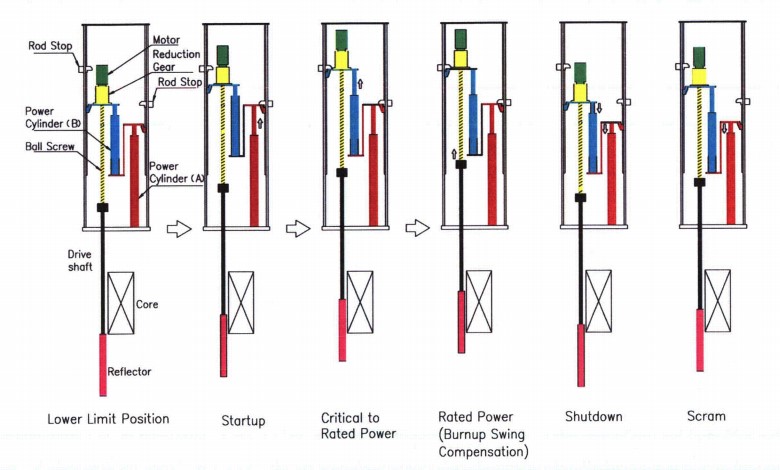 The principle of operation of reflectors. Source: Toshiba
The principle of operation of reflectors. Source: Toshiba
The absence of customary rods is not the only difference between these reactors and full-sized ones. Instead of water, liquid sodium is used for cooling. The metal does not boil and does not increase the pressure inside the reactor, but at the same time retains its properties at temperatures 200 degrees higher than water - and this is still +1 to safety. Sodium is pumped by electromagnetic pumps. 4S does not need cooling pumps; in the event of a stop, it discharges heat through the housing into the surrounding cold soil. And again, +1 to safety - the failure of the pumps due to power failure exacerbated the Fukushima accident, led to overheating of the reactors, core melting and nuclear fuel leakage.
 Schematic Toshiba 4S. Source: Toshiba
Schematic Toshiba 4S. Source: Toshiba
But the most important advantage of the Toshiba 4S is its non-maintenance. Fuel is loaded at the plant, after which the reactor has been operating at the same gas station for about 30 years. Over time, its power inevitably decreases, up to one and a half times at the end of the life cycle of the first refueling. Then the reactor is dismantled and a new one is installed in its place. In fact, this is not a waste, but a big savings. The price of one fuel assembly for the VVER-1000 reactor, depending on the country of production and the contract, fluctuates at the level of $ 0.6-1 million. There are 163 pieces of them in VVER, and each one lasts no more than 4.5-5 years. For comparison, the price of the entire Toshiba 4S nuclear power plant should theoretically be $ 25-30 million. The cost of building a high-capacity nuclear power plant is about $ 8 billion, and it varies greatly depending on the country and the number of power units.
But here, with practical implementations, the situation is even worse than in the case of RTGs. It was supposed to install the Toshiba 4S reactor in Alaska near the city of Galina, but in 2010 the project was frozen. Progress stopped under the merciless onslaught of the American bureaucratic ice rink. Nuclear power plants are a serious thing, and if they are not properly treated, they are extremely dangerous; you don’t have to go far for examples. Therefore, any project related to nuclear energy in the United States must go through the most complicated certification procedure with the Nuclear Regulatory Commission (NRC). To say that this is a monstrously long and monstrously expensive process is to downplay its complexity and cost.
Certification of a reactor at NRC requires the provision of a mass of working documentation, which for an unrealized project must be written with the assistance of qualified specialists. Its volume can easily exceed 10 thousand pages, and each will cost a lot of money. After filing the application, the commission will consider it for ... four years. We remember that nuclear energy is serious. An attempt to obtain an NRC certificate, which will give the reactor a pass to life, can easily cost $ 200 million - this is a very impressive amount that can be laid out only if you are absolutely sure of the commercial success of your project.
And this is not going smoothly. One of the prosaic reasons for the doom of “cheap” reactors is the underestimation of the costs of their maintenance. In theory, everything looks beautiful, because small reactors require the supervision of only a few people. But you also need personnel for the remaining mandatory elements of a nuclear power plant, and what money you need to invest in safety! Supervisory authorities simply will not allow leaving such an attractive object for terrorists as a nuclear power plant without powerful protection. Person after person, the staff of a cheap nuclear power plant is growing, along with it the cost of generated electricity is growing, and at some point, a peaceful atom loses to an ordinary diesel engine. This is what happened in Alaska when, after detailed calculations, it turned out that due to the high primary costs, the price of a kilowatt hour is even higher than in the case of a diesel power station. It was necessary either to greatly reduce the cost of production, or to significantly increase capacity.
Unfortunately, the Toshiba 4S did not get to the ill-fated certificate. A
preliminary application to the NRC describing the reactor remained on the Internet. But the reactor was not forgotten, Bill Gates, one of the main investors of TerraPower, engaged in the development of traveling wave reactors, became interested in it. The 4S design was taken as the basis for future development, soon the world should see the result of the collaboration.
And it would be beautiful ...
Judging by the pace of development of "green" energy, nuclear energy will never become the same everyday occurrence as a windmill or solar panel on the roof of a house. Do not see us reactors instead of a diesel generator at home, do not own smartphones with almost endless batteries. This is probably for the best. The experience of generations has shown that humanity is not always able to cope with a peaceful atom.